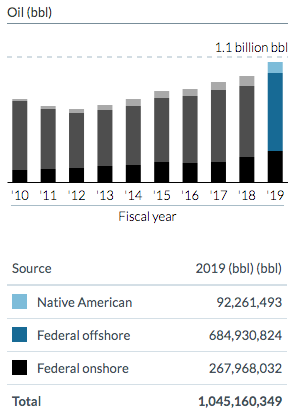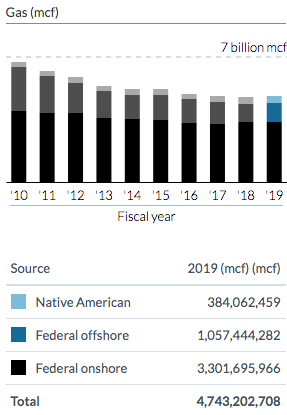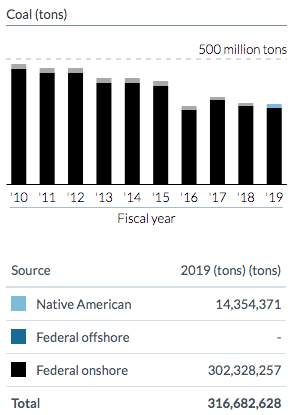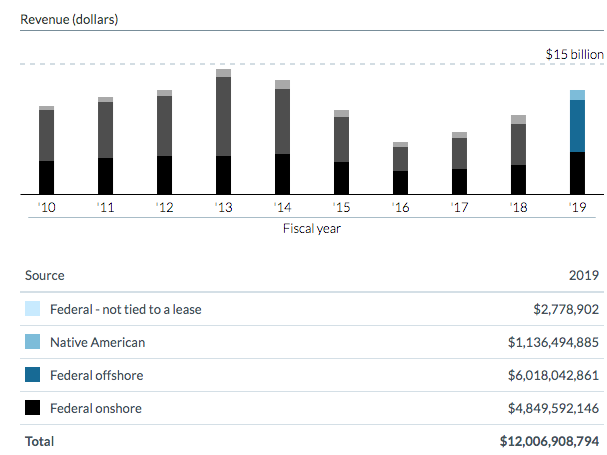In fiscal year 2019, oil production from U.S.-managed lands and waters topped a record 1 billion barrels due to technological advances and the Trump Administration’s less onerous rules on the industry. Oil production from onshore and offshore areas increased by 122.5 million barrels—up over 13 percent from fiscal year 2018 levels and almost 30 percent higher than oil production at the end of the Obama Administration. Under the Trump Administration, permits are being issued to companies more quickly without compromising the landscape and public waters. The average time it takes the Bureau of Land Management to approve drilling applications is now 108 days–down from 257 days in fiscal year 2016.
Royalties collected by the government on oil production increased to $7.5 billion in fiscal year 2019–up 21 percent from fiscal year 2018. These revenues from producing oil leases increased by $1.3 billion in comparison to fiscal year 2018 and are 122 percent higher than at the end of the Obama Administration in fiscal year 2016. The funds are divided almost equally between states where the oil is produced and the U.S. Treasury. Royalties on oil produced from Indian reservations or Indian-owned land are returned to the tribes or individual owners.

As the chart above shows, most of the oil on federal lands is produced offshore, as most of the oil production onshore is on private lands. Oil production offshore was 2.5 times higher than oil production on public lands onshore in fiscal 2019. Oil production on public lands onshore was 23 percent higher in fiscal year 2019 than in fiscal year 2018 and oil production on public lands offshore was 10 percent higher. On American Indian-owned lands, oil production increased to 92.26 million barrels and is over 52 percent more production than in fiscal year 2016.
Natural Gas
Natural gas produced on federal lands and waters in fiscal year 2019 increased to 4.743 trillion cubic feet—almost 2 percent more than fiscal year 2018 levels. Natural gas produced from Federal lands onshore was 3 times higher than natural gas produced from Federal offshore areas. While this level of natural gas production is not a record, it stops the decline in natural gas production on federal lands that occurred during the Obama Administration.

Coal
Coal production on federal lands in fiscal year 2019 total 322 million tons—2.2 percent higher than in fiscal year 2016—the last full year of the Obama Administration, but was 1.7 percent less than the previous fiscal year’s production. Retiring coal-fired power plants due to competition from low-cost natural gas and subsidized renewable energy, as well as onerous regulations that the Obama Administration instituted, have reduced the demand for coal.

Revenues
Total revenues collected in fiscal year 2019 increased by 31 percent to approximately $12 billion, nearly double that of fiscal year 2016 revenues. Over $1 billion were disbursed to American Indian Tribes and individual Indian mineral owners, which is more than double the disbursements paid in fiscal year 2016. Tribes use the revenues to develop infrastructure, provide healthcare and education and support other community development programs, such as senior centers, public safety projects and youth initiatives.
In evaluating the overall impact of energy development on public lands, the Department of Interior released an economic impact report for fiscal year 2018 that found that oil and gas produced from public lands and waters supported an estimated $85.4 billion in value-added, $139 billion in economic output and 607,000 jobs.

Conclusion
The United States is the top producer of oil and natural gas in the world due to technological advances and a productive environment established by President Trump. At the beginning of the Trump Administration, President Trump issued two executive orders regarding energy development: “Implementing an America-First Offshore Energy Strategy” and “Promoting Energy Independence and Economic Growth,” which have improved the regulatory environment and internal processes to more efficiently issue permits. As a result, there has been an upturn in the production of oil and gas on federal lands with record production of oil. The increased production has not only added revenues to the U.S. Treasury, but has also aided States and Tribes where the fuels are produced.



